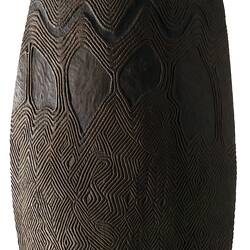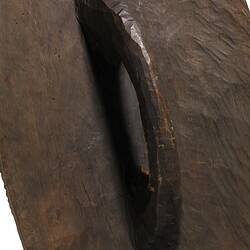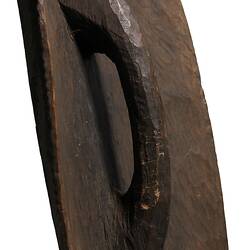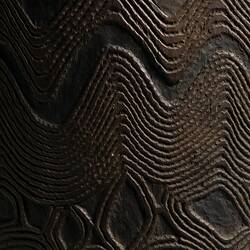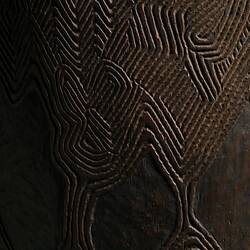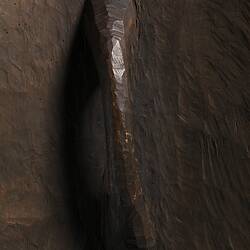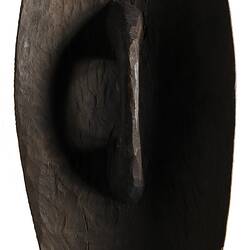Summary
The maker and Country of the traditional custodians associated with this beautiful shield were not recorded when it was acquired by Melbourne Museum in 1889. The shape of the shield and its designs indicate that it originates from South-eastern Australia. Intricate designs in wood crafted by highly-skilled makers have been a characteristic feature of the visual culture of south-eastern Australian First Peoples for countless generations.
Broad shields were used in fights and to deflect spears. Contemporary Koorie (South-eastern Australian) communities have shared their cultural knowledge and indicated that designs on wood would have been done when the wood was raw, or fresh, as it hardens over time becoming more difficult to incise. This shield was designed in the late 19th century, possibly using a stone tool or a possum-jaw engraver.
The designs and depictions on shields are highly complex in their meanings and many meanings cannot be known outside the systems of knowledge they are created within. What may look like a pretty pattern to non-First Peoples viewers may actually depict multi-layered stories about relationships between neighbouring peoples and totemic animals, all aspects of Law or maps of country relaying important information for survival such as water and food sources. Aboriginal shields in Australia had multiple uses; firstly as an effective means of physical defence, but also as an object which has the power to transmit aspects of identity and multilayered knowledge systems.
Physical Description
Elongated broad shield made from a single piece of wood. The surface comprises incised lines and gouged designs to form a distinctive pattern. The handle is cut into the reverse. The handle of this skilfully-made shield has been cut from the solid piece of wood. The carvings on the shield are extremely elaborate, featuring a complex design of diamonds, angular and curved lines, with numerous smooth spaces.
Significance
Early collectors often failed to properly document integral aspects of Aboriginal material culture such as the makers or their homelands or cultural grouping. Objects like this shield were originally collected as part of the growing interest in Ethnography and Anthropology during the 19th Century and the incorrect and belief that First Peoples people of Australia were a 'dying race'.
Objects in museum collections are today illuminated by the knowledge of contemporary First Peoples communities who, through their connection to Country and continuation of culture, have an understanding both of the meaning of the patterns and designs depicted in carvings and the processes used to produce them. Several contemporary First Peoples artists have incorporated shields into their practice. Wiradjuri/Kamilaroi artist and researcher Jonathan Jones explores contemporary Koorie peoples connection to the multi-layered knowledge systems depicted on shields;
'They're very much something that the south-east men did amazingly well and are amazingly distinctive. You can spot a south-east shield from a mile away and something our men were really proud of and really defined and united this region. I think there's something very special in them as holding a lot of cultural knowledge.' Jonathan Jones, 2016.
During a visit to the Melbourne Museum in 2012, Sir David Attenborough was shown this shield. He said:
'It is worth travelling to the other side of the world just to see this magnificent treasure - it is truly remarkable'.
References
Sydney Morning Herald, Aboriginal artefacts in Sotheby's auction prompt questions over provenance, 2016, Viewed 1 September 2017.
http://www.smh.com.au/entertainment/art-and-design/melbourne-arts/aboriginal-artefacts-in-sothebys-auction-prompt-questions-over-provenance-20160902-gr7509.html
More Information
-
Object/Medium
Shield
-
Locality
-
Date Produced
-
Date Collected
-
Overall Dimensions
300 mm (Width), 85 mm (Depth), 1170 mm (Height)
-
Classification
-
Date Made
-
Maker
-
Clan/Language Group
-
Place Made
-
Indigenous Region
-
Type of item
-
Discipline
-
Category
-
Collecting Areas

